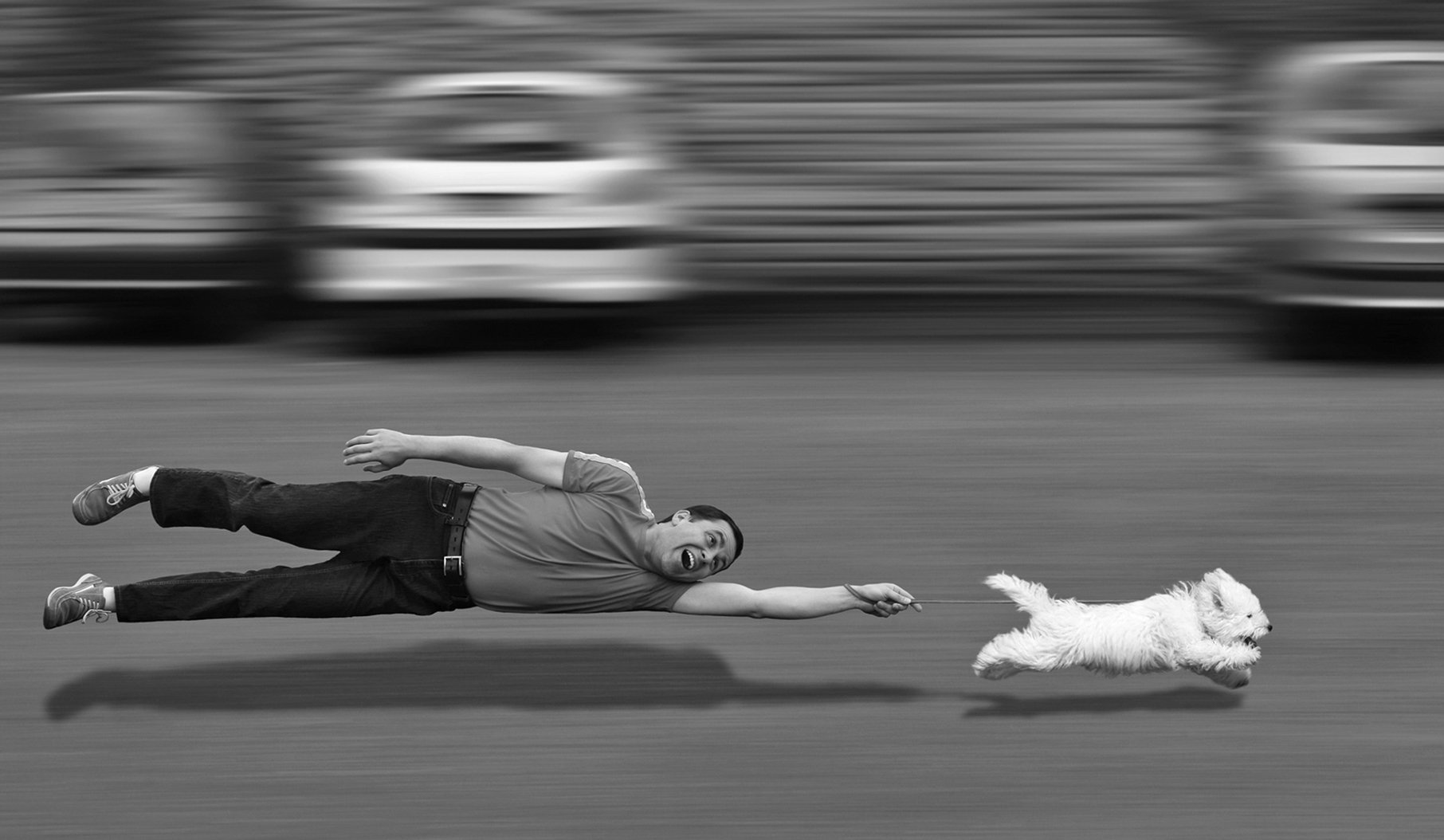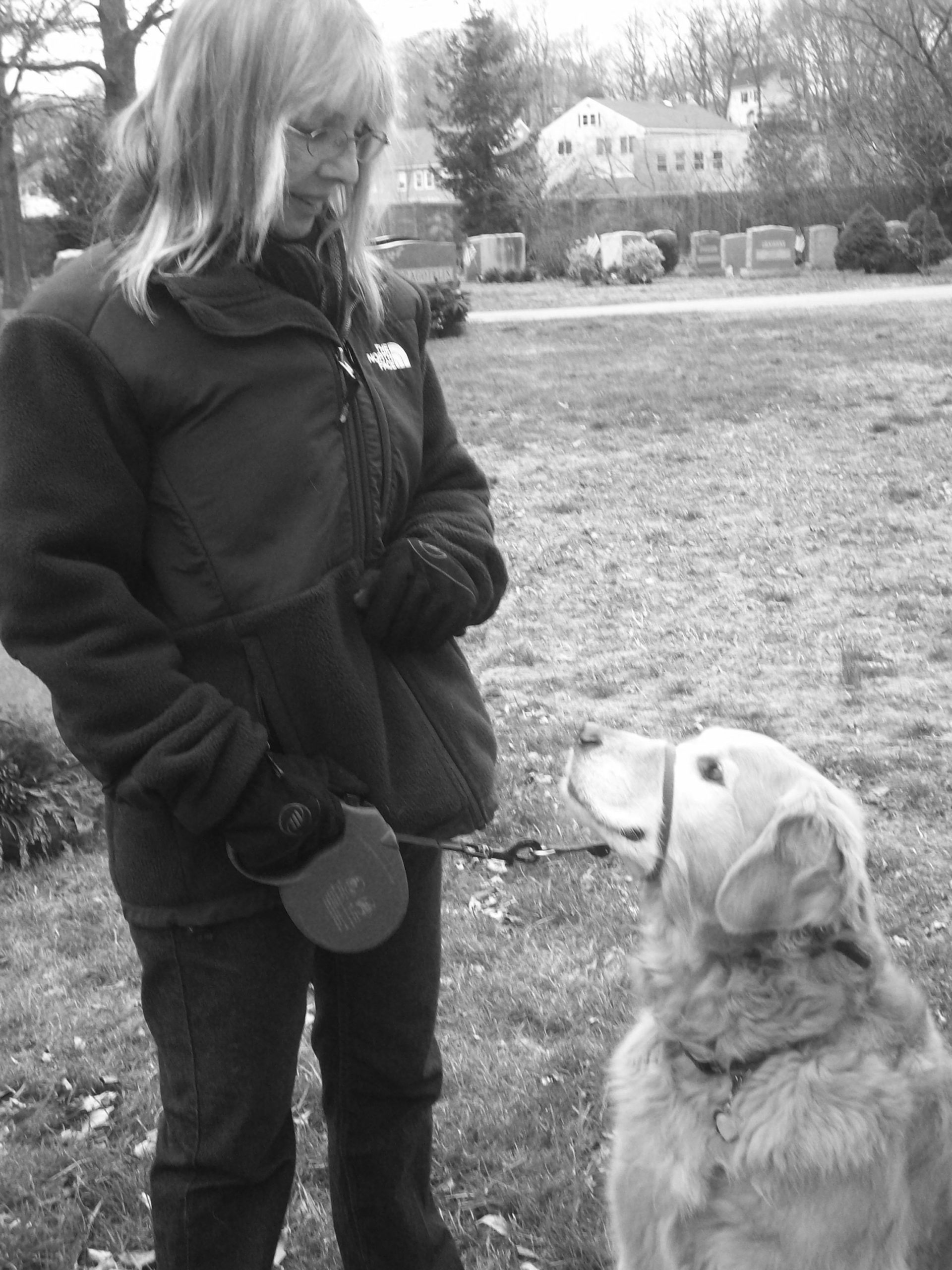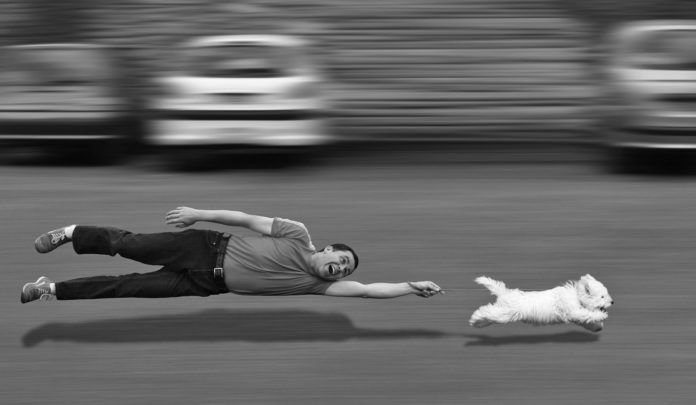Go to a dog park any morning, and along with birds twittering you will hear dogs choking and gagging as they pull on their leashes to try to get their owners to go where they want. The owners, for their part, spend nearly all their time tugging unpleasantly and often uselessly. They end up either rooted to a spot because the dog is not done sniffing and will not respond to being pulled by the leash or, worse, being dragged along from behind like Olive Oyl, powerless. Of course, people should exercise patience when their dog reads his environment through sniffing or wants to explore, but often it’s as if the dog uses the leash to control the owner’s movements rather than the other way around.
Bigstock

The reason is simple. With the traditional collar that is placed around a dog’s neck, he can easily ignore messages sent by tugging on a leash attached to that collar. “Dogs don’t have that many nerve endings at the base of their neck, where the collar rides,” explains Nicholas Dodman, BVMS, director of the Behavior Clinic at Tufts Cummings School. “That area is pretty insensitive. Dogs are not biologically programmed to receive messages there.”
That’s actually the case for most species. Indeed, Dr. Dodman says in his excellent book, The Well Adjusted Dog, “every other species is controlled by the head. Horses are controlled with a bridle, cows and sheep with a head halter, bulls with a ring in the nose, and pigs with a hog snare. Yet for generations, trainers have focused their best and worst attentions on the dog’s neck.”
In fact, when the traditional flat collar doesn’t work to keep a dog in line, many people go on what Dr. Dodman calls a “fool’s errand” and graduate to a choke collar that tightens around the neck when the leash is pulled. But that doesn’t set things right, either. It simply forces the dog to do what you want by causing discomfort or even frank pain. The pressure that some trainers euphemistically call “corrections” are physical punishments that must be inflicted over and over to keep the dog compliant, eroding all trust between pet and owner. Worse still, that pressure causes considerable physical damage. A postmortem study of dogs trained with choke collars showed that physical damage to tissues and bone in their necks occurred in greater than 90 percent of them.
Some dogs don’t even respond to the choke collar as wanted, ignoring the pressure it exerts as best as possible and continuing to misbehave. That’s when owners might move on to a device that can inflict even greater pain — the prong collar. “It’s like fitting a dog with a piece of barbed wire,” Dr. Dodman says. “You can certainly stop a kid from running around the store by pulling on a piece of barbed wire around his neck, but it’s not appropriate.” And again, he cautions, “you’re not teaching what to do. You’re teaching what not to do, which is never as effective for changing behavior.”
So what is the solution for an owner whose dog uses the leash to lead him?
Enter the head halter
You’ve seen some dogs wearing head halters. They’re the collars with one thin strap that goes around the muzzle, up near the eyes, and another thin strap that goes around the neck but higher up than regular collars, closer to a dog’s ears than the base of his neck. Perhaps because they consist of two straps rather than one, they look too confining for a dog, or too difficult to get the hang of. Neither supposition is correct. Head halters are quite comfortable for dogs and, once you know how to put one on, are a cinch to use.
The reason they’re so beneficial is that they have biological resonance for a dog. When a dog is a puppy, his mother sends messages of disapproval for undesirable behavior by holding his snout with her mouth. It doesn’t hurt. It just says, “I don’t like that. Stop it.” That region of a dog’s head, called the maternal point, is dense with sensory nerve endings that detect touch and pressure, so it doesn’t take much from a dog’s mother to make her rebuke. Likewise, it doesn’t take more than gentle tension applied to the strap around the same area of the upper nose to let your dog know you are not pleased with the direction he wants to take. You just need to pull upward ever so lightly on the leash.
The other loop of a dog’s head halter, the one that goes high up on the scruff of his neck, is also dense with nerve endings. His mother will clamp down there to grasp and then transport her pup from one place to another. It has the effect of relaxing the dog, letting him know that he is being taken care of by someone else. This area around a dog’s upper neck is referred to as the “leader point” or “relaxation point.” When tension is applied with a tug on the leash, an impression is made on the maternal point and the leader point at the same time, causing the dog not only to pay attention to you but also to relax.
The effect is often so immediate that many dogs who are notorious tuggers, always lunging and dragging their owners with no respect, stop pulling after three to four minutes. “It’s like power steering,” Dr. Dodman says. In many cases, instead of being brought into a tug of war, all you have to do is stand still. You don’t even have to pull up on the lead. If the dog is trying to pull you forward, the tension on his nose will automatically cause him to turn his head and make him look up at you. If he’s hanging back, it’s the neck strap that will tense. He’ll auto-correct within 10 or 20 seconds, much sooner once he gets the hang of it, either by walking back to you or forward to you to release the tension. At that point you can tell him what a good boy he is. (You don’t need him to “heel” precisely beside your feet like a little soldier. That’s only for show dogs. You just want him to keep pace with you and walk with a loose lead.)
At times, instead of standing still like a tree until your dog walks back to you or catches up with you, you may have to pull up on the leash ever so slightly to apply a bit more pressure around the muzzle and upper neck. That might be the case, say, if your dog tries to jump on another dog, or a person. But that, too, will be easy. Even a large dog can’t pull a slight person where she doesn’t want him to go if the dog is fitted properly with a head halter that is used gently to control his movements.
Add in word cues, such as “No Pull” or “Wait,” followed by praise when the dog complies (because he has to), and he may eventually get the hang of walking where and when you want with the word cue alone and no tension applied to the head halter whatsoever.
If you’re a cream puff of an owner whose dog has always had the upper paw, so to speak, you may want to put a little psychological oomph into it so your pet respects your wishes more in general. When standing still with the leash or applying a bit of pressure by pulling it up toward you, look directly into your dog’s eyes, which he will take as a sign that you are not about to back down. Also, don’t use your voice to try to talk your dog into doing what you want — no whining or exasperation. Just speak in friendly but firm terms. Finally, when he is by your side again, praise him and gently stroke him, starting above his eyes and then going over the top of his head to the nape of his neck. That, Dr. Dodman says, sends a powerful signal of your leadership.
If the Dog Refuses the Head Halter
It’s best to adjust a dog to a head halter when he is still a puppy. You can find petite sizes meant for puppies as young as three months old. About half take to it without any fuss, while the other half struggle to get out of it and require you to apply a little steady, upward tension on the leash so they get the correct signals about who is in control. It may take a few tries, but a young dog will soon get the picture.

It’s different for dogs who are one year of age or older. They already know, and enjoy, the relative autonomy that traditional flat collars allow and may resist having a head halter fitted. Some will struggle for more than 10 minutes to get it off, in fact, although it will not come off if fitted correctly. This is where many owners give up. Don’t. Most dogs, even adult dogs, adjust after a few tries. In some cases, you may have to start by fitting the dog with the neck band only and then graduating to the nose band after a week or so.
That said, Dr. Dodman does caution that some adult dogs, perhaps one in seven, simply will not tolerate a head halter. They never give up rubbing their noses along the floor or pawing at the thing in an attempt to get it off. Or worse, they might go to bite you when you try to put it on because they don’t want you near their face.
In such cases, you should consider trying a body harness.
The Ins and Outs of a Body Harness
For dogs who are never going to accept a head halter, a body harness makes a reasonable alternative. Body harnesses are also the right choice for dogs who cannot wear a head halter because of their anatomy. These would include pugs and other dogs with noses too short to put a strap around. (Such dogs should not be placed in a traditional neck collar, either. Neck collars of any kind, even ones that do not choke or stab, can prove dangerous for Toy and brachycephalic breeds, who have narrow tracheas, or windpipes, that might inadvertently be pinched via tugging.)
A body harness will not work as quickly or as powerfully as a head halter. Dogs are not programmed to receive messages around the chest. But it will work better to get a dog where you want — and keep him from going where you don’t want — than a traditional flat collar that goes around the base of the neck. When you pull up on the lead and make the harness into a bit of a tent, a dog will become “kind of puzzled,” Dr. Dodman says. “He’ll feel the upward tension and initially not know how to respond. You’ll see him start to blink, which is a sign that he’s thinking. Then he might lick his lips, a sign of submission, or deference. Eventually, he’ll stop trying to pull and sit down, which is your cue to say, ‘Good dog! Nice sit!'”
It might take an hour to learn the harness, as opposed to a few minutes for a head halter, Dr. Dodman says. And you may have to have more than one session. But once you get the hang of it, you will definitely have more control over your dog than you would with a simple neck collar. As with a head halter, Dr. Dodman says, your strong-minded dog will no longer be able to tow you down the street “like a water-skier behind a powerboat.”





